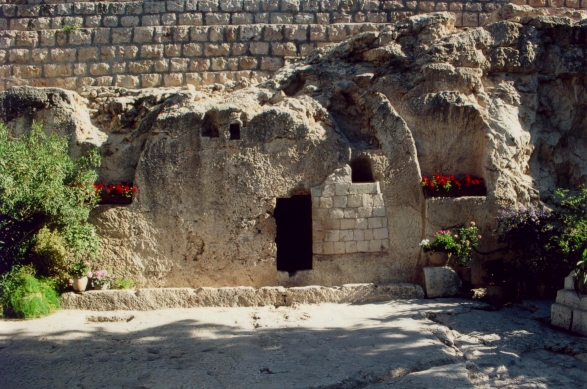'There was a garden, and in the garden a new tomb': Is this the true site of the Resurrection?

For hundreds of thousands who come each year, the vast Church of the Holy Sepulchre in Jerusalem's Old City is the focal point of their pilgrimage.
The site was identified as that of Jesus's crucifixion and burial by representatives of the Roman emperor Constantine, in AD 326.
For some, however, the bustle – and sometimes low-level violence – of the Holy Sepulchre is too much, as different denominations compete over territory and service times within the church.
For them, a more peaceful alternative can be found outside the Old City's walls, at the so-called Garden Tomb site, once Anglican-dominated and now non-denominational.
Tucked away off an inconspicuous side-street near the main bus stop in rowdy north-east Jerusalem, is an oasis of a garden, one which organisers insist lays no claims to be even 'probably' the true location. But it is nonetheless an intriguing spot, where Christians come to meditate on the death and Resurrection of Jesus.
Those who hold the Garden Tomb to be the correct site – and they are many, many fewer than those who believe in the Holy Sepulchre – point to a number of reasons for their view.
Perhaps the most important is the line in the Gospel of John: 'At the place where Jesus was crucified, there was a garden, and in the garden a new tomb, in which no one had ever been laid' (John: 19:41).
The second is the Gospel references to Golgotha, or 'skull' or 'place of the skull', and Calvary: the garden is located on a hill (known now as 'Skull Hill') on which a shape that looks (to some extent and only arguably) like a skull can be seen.
'As early as 1842, a German theologian called Otto Thenius proposed the idea that the outcropping of rock known today as "Skull Hill" could possibly be significant in the identification of the site of the crucifixion,' says the Garden Tomb's wesbite. 'That idea lay seemingly dormant for quite some time until General Charles Gordon on sabbatical in the area (1883) began to publish similar ideas. Because of his importance in British society at that time the idea took hold and people began to look seriously at the claims that this could possibly be the site listed in the New Testament as Golgotha (Aramaic) or Calvary (Latin) – the place of the skull.'
Two ladies in particular, Charlotte Hussey and Louisa Hope, followed these ideas and began to take them seriously, and thought that the place ought to be preserved.

In 1867 an ancient Jewish tomb was discovered at the site. The Garden Tomb website points out that 'The tomb is described as being a tomb cut out of rock, belonging to a wealthy man...Joseph of Arimathea. It had a weeping chamber, a burial chamber, it was sealed with a rolling stone, it had a traditionally low doorway through which the disciples were forced to stoop in order to look into (and enter) the tomb that morning.'
On September 22, 1892 a notice was placed in The Times asking people to donate the funds necessary to purchase the site, which had been offered for sale by a German family. The Garden Tomb Association was formally established in 1893 and the purchase of the property was bought about in 1894, though it would actually be a number of years before all the legal formalities were completed.
Then there is the centrality of the location in the city: some 200 metres from the Damascus Gate, close to the main road leading north. This would be in line with the Roman tendency to execute people in view of passers by. Further, the location was apparently a traditional site for Jewish executions by stoning, and is said to be the place where St. Stephen was killed (the Damascus Gate was previously known as St Stephen's Gate).
It is important to stress that those who work at the Garden Tomb are quick to point out that they make no dogmatic claims, and instead say the place serves as a 'visual aid' for worshipping Christians in Jerusalem.
But the site has grown in popularity since its foundation in 19th century. Now, organisers claim that around a quarter of a million people visit each year.
Peter Hitchens, the Mail on Sunday columnist and a practising Christian who is a fan of the site, tells Christian Today: 'It's the only Protestant pilgrimage site in Jerusalem, I suppose, and as likely as any of the other more gaudy and knick-knack infested ones to be genuine. I had heard that the most likely location of Golgotha was the east Jerusalem bus station north of the Damascus Gate.
'It's also rather a lovely garden, and so appeals to those of us who see gardens as especially dear to God, and scripture as a journey from the Garden of Eden to the Garden of Gethsemane, and [there is] Mary Magdalene, seeing the risen Christ and "supposing him to be the gardener", so there must have been a garden there too.'
However, many orthodox Christians would argue that the Garden Tomb is little more than a pretty garden, with a tomb. A series of arguably spurious links have caused a relative few to hold it as the true site of the central event in Christianity.
Millions would instead point to the Holy Sepulchre as the true site.
Whatever the truth however, the Garden Tomb, especially on a hot day in Jerusalem, certainly provides respite and space to pray.











